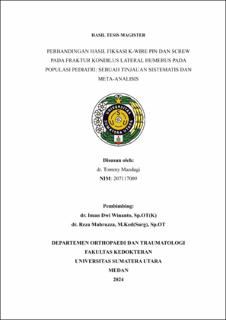Perbandingan Hasil Fiksasi K-Wire Pin dan Screw pada Fraktur Kondilus Lateral Humerus pada Populasi Pediatri: Sebuah Tinjauan Sistematis dan Meta-Analisis
Comparison of K-Wire Pin and Screw Fixation Results in Lateral Condyle Humerus Fractures in Pediatric Populations: A Systematic Review and Meta-Analysis

Date
2024Author
Mandagi, Tommy
Advisor(s)
Winanto, Iman Dwi
Mahruzza, Reza
Metadata
Show full item recordAbstract
Background:
Lateral condyle fractures of the humerus in children are common injuries, often resulting from
direct trauma or blunt force. Proper management is essential to avoid long-term complications
such as malunion, nonunion, or joint stiffness. The fixation methods of K-wire pin and screw
are frequently used, but there is limited consensus regarding their effectiveness. This study
aims to systematically review and compare the clinical outcomes of both fixation techniques
in pediatric patients with lateral condyle humerus fractures.
Methods:
A systematic review and meta-analysis were conducted on studies comparing K-wire pin and
screw fixation methods in pediatric patients. Data from multiple databases, including PubMed,
Scopus, and EMBASE, were analyzed. The primary outcomes assessed were union rates,
infection, stiffness, and functional recovery.
Results:
The meta-analysis revealed that screw fixation provided greater stability, a lower risk of
infection, and quicker recovery compared to K-wire pin fixation. However, K-wire pin fixation,
while more cost-effective, carries a higher risk of complications such as infection and fragment
displacement.
Conclusion:
Screw fixation appears to offer superior clinical outcomes in terms of stability and functional
recovery, making it the preferred choice for managing lateral condyle fractures in children.
However, K-wire pin fixation remains a viable option, particularly in cases where cost-
effectiveness is prioritized.
Collections
- Master Theses [72]
